Abstract
The study of the pathophysiology of seasonal affective disorder (SAD, also known as winter depression) has historically been intimately linked to investigations into the mechanisms of action of light therapy. This paper reviews the studies on the pathophysiology of SAD with emphasis on circadian, neurotransmitter, and genetic hypotheses. There is substantial evidence for circadian phase shift and serotonergic hypotheses, but conflicting results may indicate that SAD is a biologically heterogeneous condition. Recent progress in defining the molecular mechanisms of the human circadian clock and retinal phototransduction of light will provide important new directions for future studies of the etiology and pathophysiology of SAD.
Full text
PDF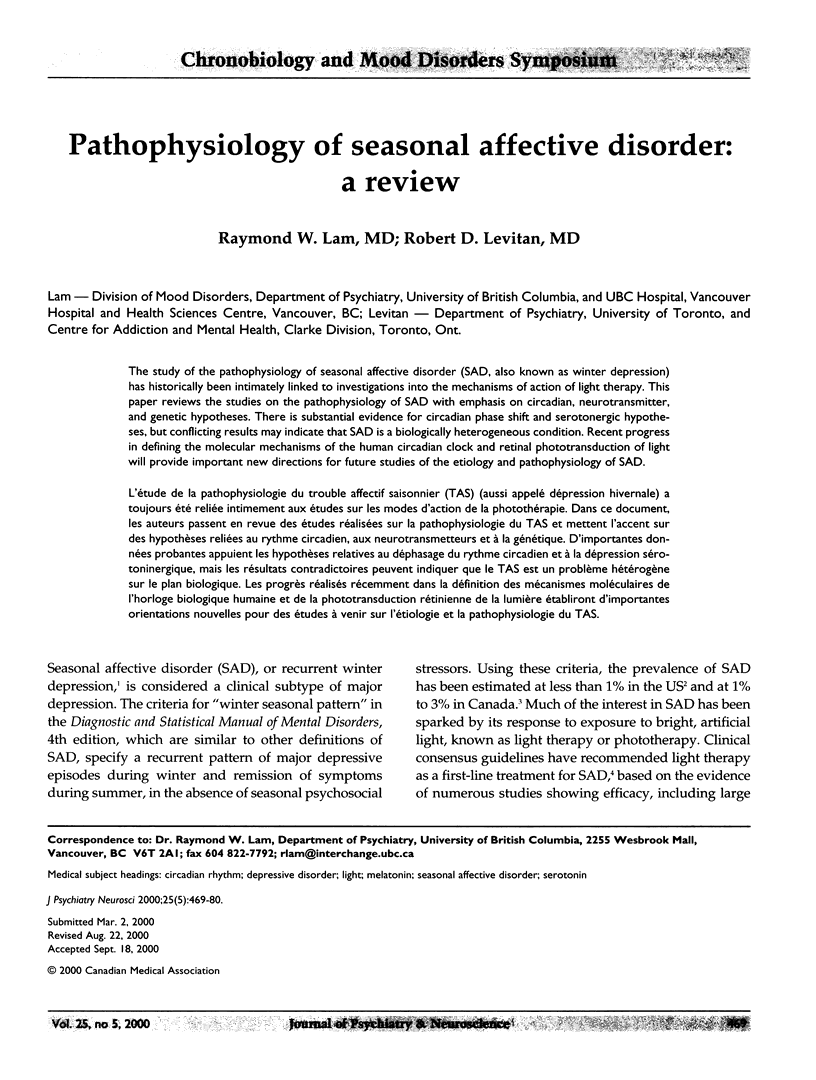

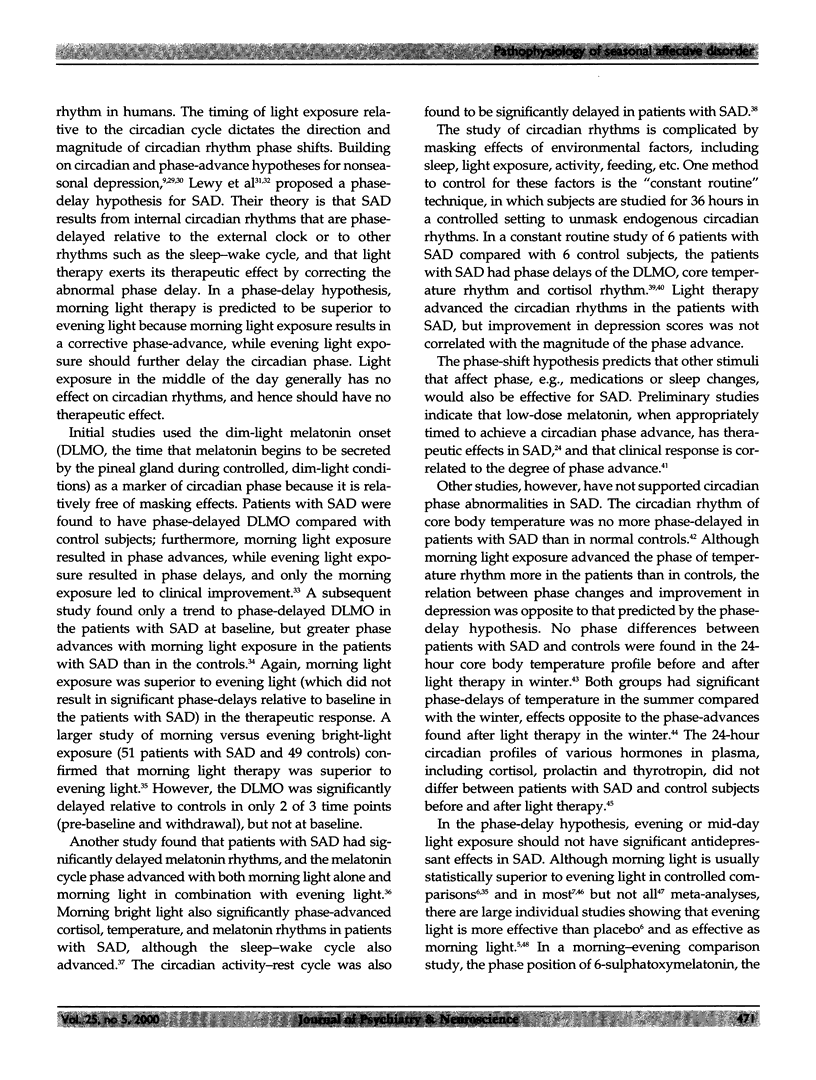

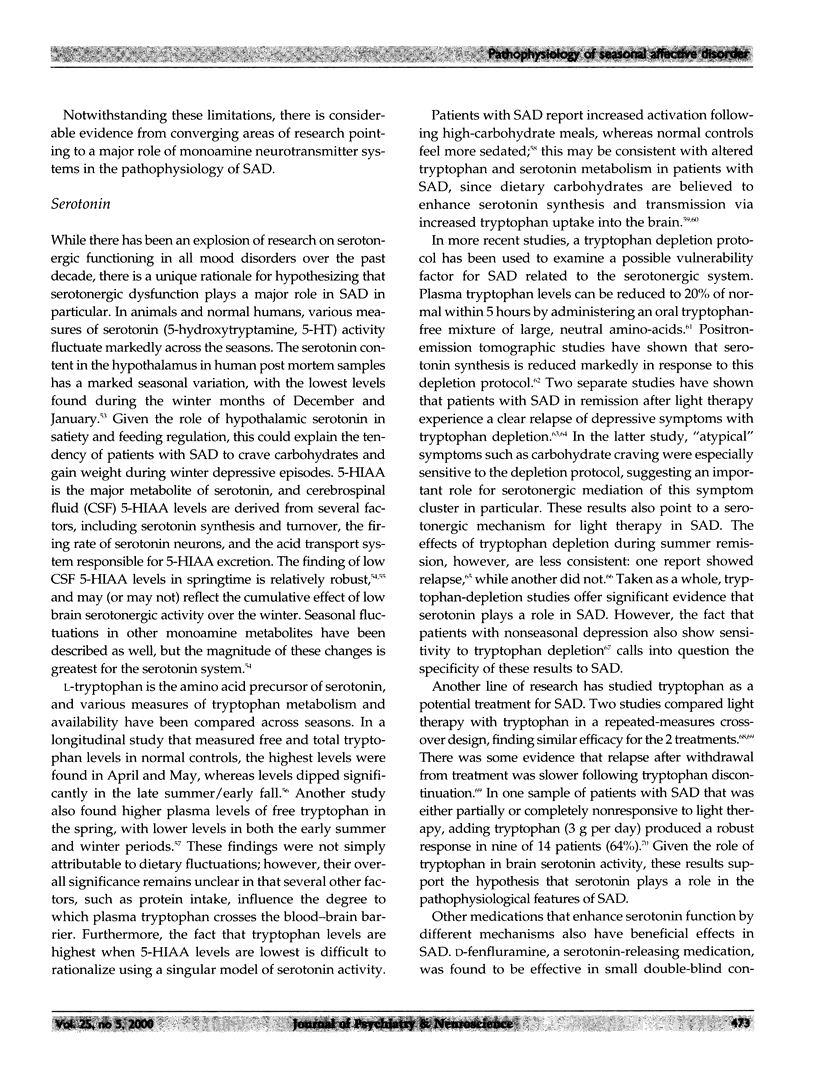
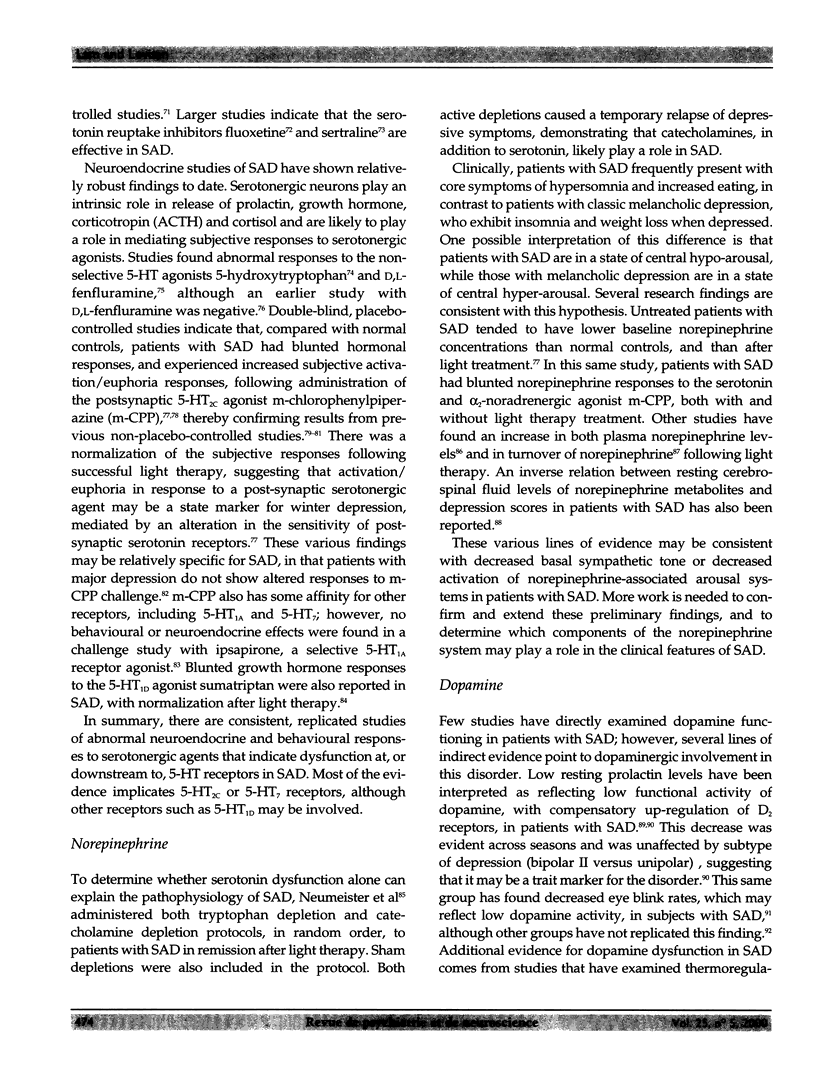

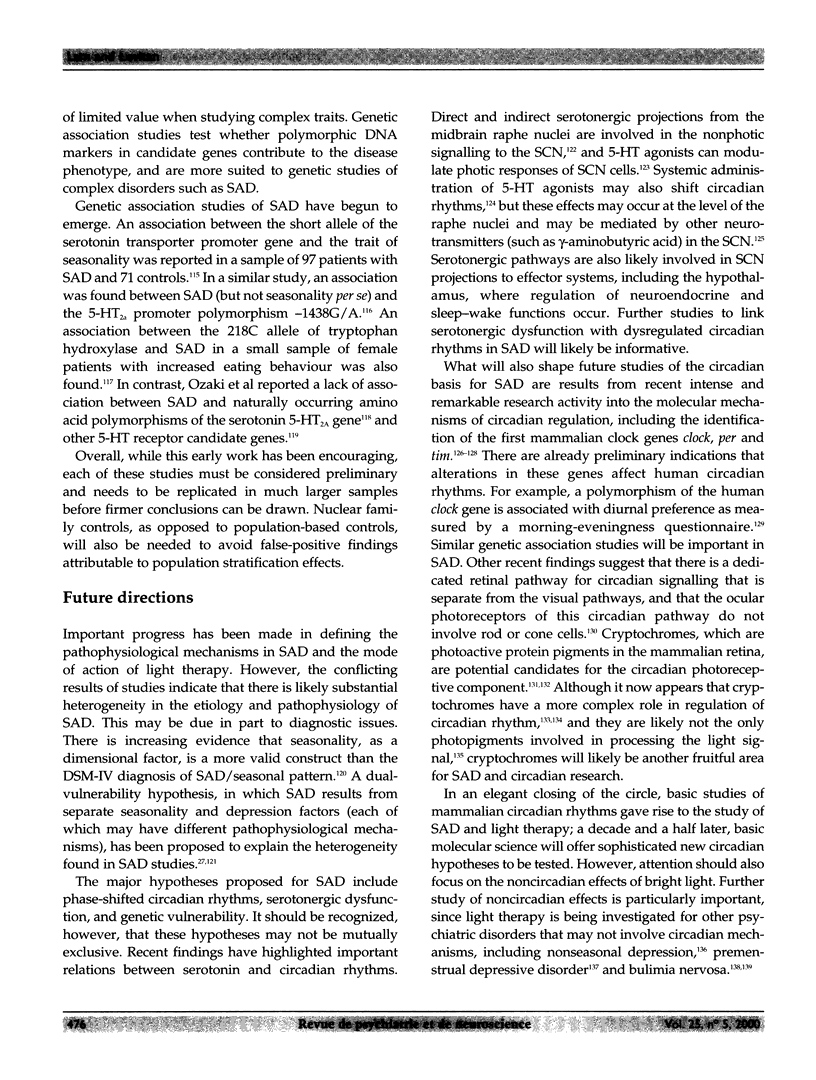

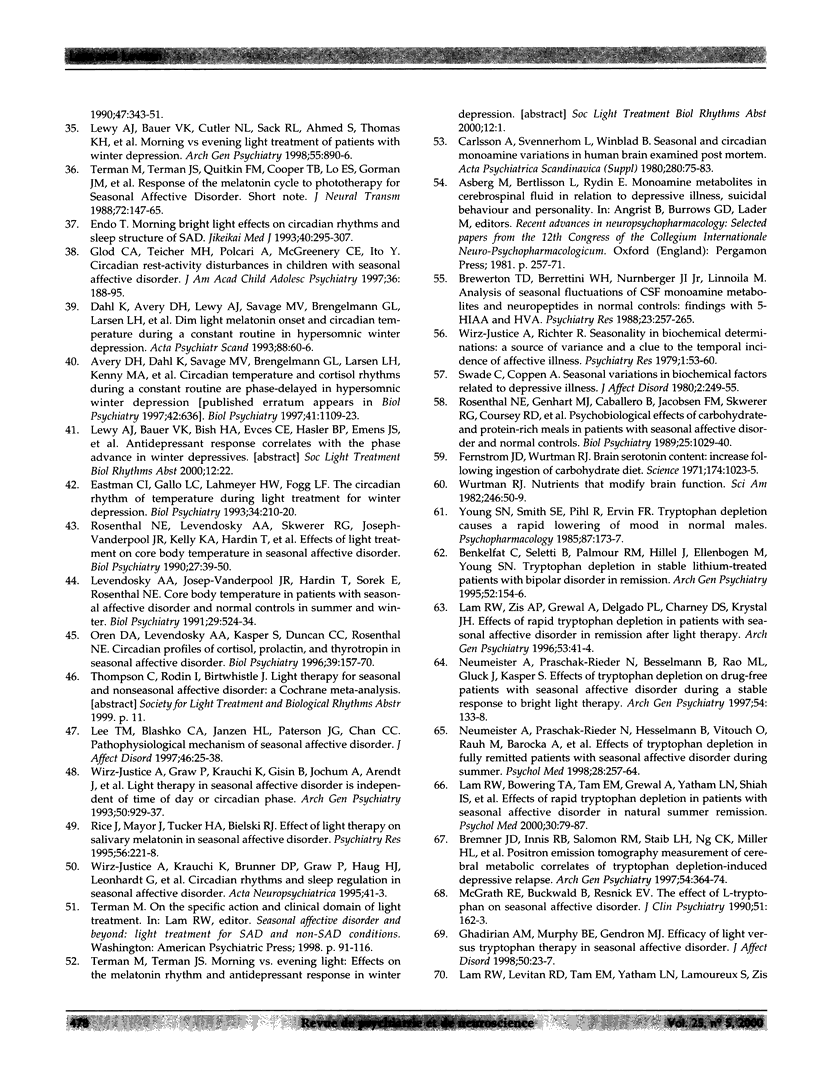
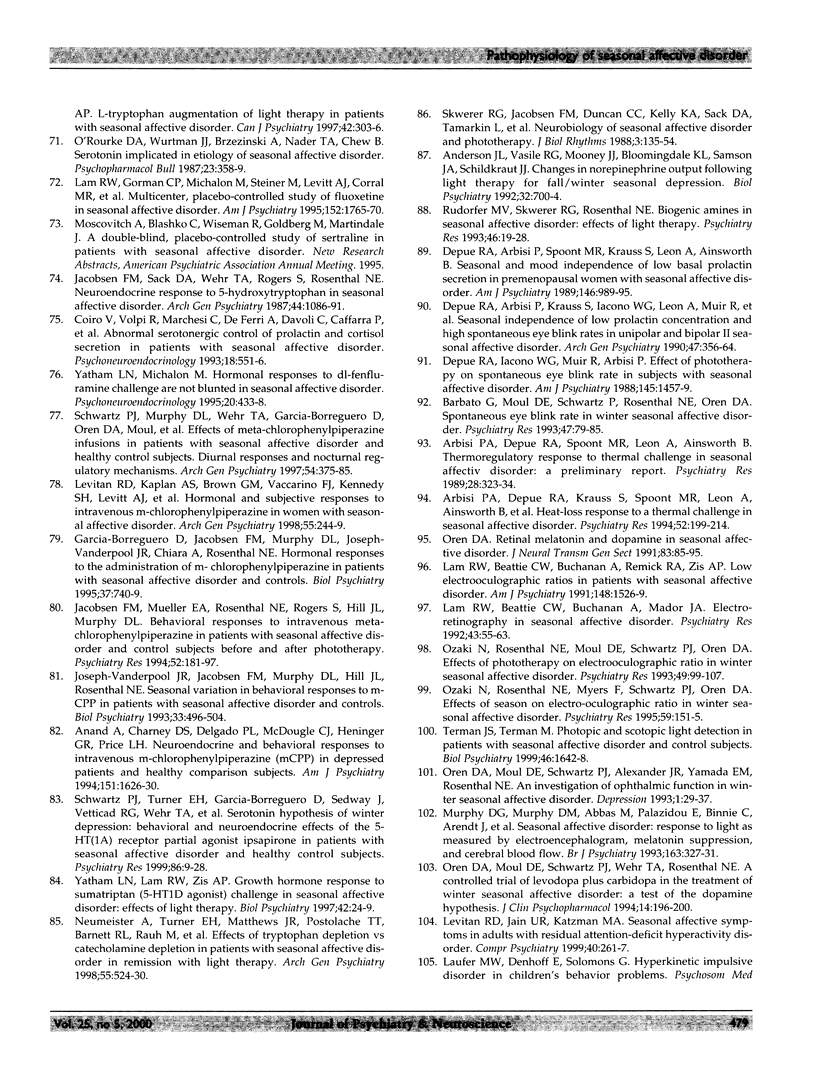

Selected References
These references are in PubMed. This may not be the complete list of references from this article.
- Anand A., Charney D. S., Delgado P. L., McDougle C. J., Heninger G. R., Price L. H. Neuroendocrine and behavioral responses to intravenous m-chlorophenylpiperazine (mCPP) in depressed patients and healthy comparison subjects. Am J Psychiatry. 1994 Nov;151(11):1626–1630. doi: 10.1176/ajp.151.11.1626. [DOI] [PubMed] [Google Scholar]
- Anderson J. L., Vasile R. G., Mooney J. J., Bloomingdale K. L., Samson J. A., Schildkraut J. J. Changes in norepinephrine output following light therapy for fall/winter seasonal depression. Biol Psychiatry. 1992 Oct 15;32(8):700–704. doi: 10.1016/0006-3223(92)90299-f. [DOI] [PubMed] [Google Scholar]
- Arbisi P. A., Depue R. A., Krauss S., Spoont M. R., Leon A., Ainsworth B., Muir R. Heat-loss response to a thermal challenge in seasonal affective disorder. Psychiatry Res. 1994 May;52(2):199–214. doi: 10.1016/0165-1781(94)90088-4. [DOI] [PubMed] [Google Scholar]
- Arbisi P. A., Depue R. A., Spoont M. R., Leon A., Ainsworth B. Thermoregulatory response to thermal challenge in seasonal affective disorder: a preliminary report. Psychiatry Res. 1989 Jun;28(3):323–334. doi: 10.1016/0165-1781(89)90213-8. [DOI] [PubMed] [Google Scholar]
- Avery D. H., Dahl K., Savage M. V., Brengelmann G. L., Larsen L. H., Kenny M. A., Eder D. N., Vitiello M. V., Prinz P. N. Circadian temperature and cortisol rhythms during a constant routine are phase-delayed in hypersomnic winter depression. Biol Psychiatry. 1997 Jun 1;41(11):1109–1123. doi: 10.1016/S0006-3223(96)00210-7. [DOI] [PubMed] [Google Scholar]
- Barbato G., Moul D. E., Schwartz P., Rosenthal N. E., Oren D. A. Spontaneous eye blink rate in winter seasonal affective disorder. Psychiatry Res. 1993 Apr;47(1):79–85. doi: 10.1016/0165-1781(93)90057-n. [DOI] [PubMed] [Google Scholar]
- Benkelfat C., Seletti B., Palmour R. M., Hillel J., Ellenbogen M., Young S. N. Tryptophan depletion in stable lithium-treated patients with bipolar disorder in remission. Arch Gen Psychiatry. 1995 Feb;52(2):154–156. doi: 10.1001/archpsyc.1995.03950140072010. [DOI] [PubMed] [Google Scholar]
- Blazer D. G., Kessler R. C., Swartz M. S. Epidemiology of recurrent major and minor depression with a seasonal pattern. The National Comorbidity Survey. Br J Psychiatry. 1998 Feb;172:164–167. doi: 10.1192/bjp.172.2.164. [DOI] [PubMed] [Google Scholar]
- Blouin A. G., Blouin J. H., Iversen H., Carter J., Goldstein C., Goldfield G., Perez E. Light therapy in bulimia nervosa: a double-blind, placebo-controlled study. Psychiatry Res. 1996 Feb 28;60(1):1–9. doi: 10.1016/0165-1781(95)02532-4. [DOI] [PubMed] [Google Scholar]
- Bremner J. D., Innis R. B., Salomon R. M., Staib L. H., Ng C. K., Miller H. L., Bronen R. A., Krystal J. H., Duncan J., Rich D. Positron emission tomography measurement of cerebral metabolic correlates of tryptophan depletion-induced depressive relapse. Arch Gen Psychiatry. 1997 Apr;54(4):364–374. doi: 10.1001/archpsyc.1997.01830160092012. [DOI] [PubMed] [Google Scholar]
- Brewerton T. D., Berrettini W. H., Nurnberger J. I., Jr, Linnoila M. Analysis of seasonal fluctuations of CSF monoamine metabolites and neuropeptides in normal controls: findings with 5HIAA and HVA. Psychiatry Res. 1988 Mar;23(3):257–265. doi: 10.1016/0165-1781(88)90016-9. [DOI] [PubMed] [Google Scholar]
- Carlsson A., Svennerholm L., Winblad B. Seasonal and circadian monoamine variations in human brains examined post mortem. Acta Psychiatr Scand Suppl. 1980;280:75–85. [PubMed] [Google Scholar]
- Checkley S. A., Murphy D. G., Abbas M., Marks M., Winton F., Palazidou E., Murphy D. M., Franey C., Arendt J. Melatonin rhythms in seasonal affective disorder. Br J Psychiatry. 1993 Sep;163:332–337. doi: 10.1192/bjp.163.3.332. [DOI] [PubMed] [Google Scholar]
- Chrousos G. P., Gold P. W. The concepts of stress and stress system disorders. Overview of physical and behavioral homeostasis. JAMA. 1992 Mar 4;267(9):1244–1252. [PubMed] [Google Scholar]
- Cohen R. M., Gross M., Nordahl T. E., Semple W. E., Oren D. A., Rosenthal N. Preliminary data on the metabolic brain pattern of patients with winter seasonal affective disorder. Arch Gen Psychiatry. 1992 Jul;49(7):545–552. doi: 10.1001/archpsyc.1992.01820070039006. [DOI] [PubMed] [Google Scholar]
- Coiro V., Volpi R., Marchesi C., De Ferri A., Davoli C., Caffarra P., Rossi G., Caffarri G., Davolio M., Chiodera P. Abnormal serotonergic control of prolactin and cortisol secretion in patients with seasonal affective disorder. Psychoneuroendocrinology. 1993;18(8):551–556. doi: 10.1016/0306-4530(93)90032-g. [DOI] [PubMed] [Google Scholar]
- Dahl K., Avery D. H., Lewy A. J., Savage M. V., Brengelmann G. L., Larsen L. H., Vitiello M. V., Prinz P. N. Dim light melatonin onset and circadian temperature during a constant routine in hypersomnic winter depression. Acta Psychiatr Scand. 1993 Jul;88(1):60–66. doi: 10.1111/j.1600-0447.1993.tb03414.x. [DOI] [PubMed] [Google Scholar]
- Depue R. A., Arbisi P., Krauss S., Iacono W. G., Leon A., Muir R., Allen J. Seasonal independence of low prolactin concentration and high spontaneous eye blink rates in unipolar and bipolar II seasonal affective disorder. Arch Gen Psychiatry. 1990 Apr;47(4):356–364. doi: 10.1001/archpsyc.1990.01810160056009. [DOI] [PubMed] [Google Scholar]
- Depue R. A., Arbisi P., Spoont M. R., Krauss S., Leon A., Ainsworth B. Seasonal and mood independence of low basal prolactin secretion in premenopausal women with seasonal affective disorder. Am J Psychiatry. 1989 Aug;146(8):989–995. doi: 10.1176/ajp.146.8.989. [DOI] [PubMed] [Google Scholar]
- Depue R. A., Iacono W. G., Muir R., Arbisi P. Effect of phototherapy on spontaneous eye blink rate in subjects with seasonal affective disorder. Am J Psychiatry. 1988 Nov;145(11):1457–1459. doi: 10.1176/ajp.145.11.1457. [DOI] [PubMed] [Google Scholar]
- Eastman C. I., Gallo L. C., Lahmeyer H. W., Fogg L. F. The circadian rhythm of temperature during light treatment for winter depression. Biol Psychiatry. 1993 Aug 15;34(4):210–220. doi: 10.1016/0006-3223(93)90074-n. [DOI] [PubMed] [Google Scholar]
- Eastman C. I., Young M. A., Fogg L. F., Liu L., Meaden P. M. Bright light treatment of winter depression: a placebo-controlled trial. Arch Gen Psychiatry. 1998 Oct;55(10):883–889. doi: 10.1001/archpsyc.55.10.883. [DOI] [PubMed] [Google Scholar]
- Enoch M. A., Goldman D., Barnett R., Sher L., Mazzanti C. M., Rosenthal N. E. Association between seasonal affective disorder and the 5-HT2A promoter polymorphism, -1438G/A. Mol Psychiatry. 1999 Jan;4(1):89–92. doi: 10.1038/sj.mp.4000439. [DOI] [PubMed] [Google Scholar]
- Fernstrom J. D., Wurtman R. J. Brain serotonin content: increase following ingestion of carbohydrate diet. Science. 1971 Dec 3;174(4013):1023–1025. doi: 10.1126/science.174.4013.1023. [DOI] [PubMed] [Google Scholar]
- Garcia-Borreguero D., Jacobsen F. M., Murphy D. L., Joseph-Vanderpool J. R., Chiara A., Rosenthal N. E. Hormonal responses to the administration of m-chlorophenylpiperazine in patients with seasonal affective disorder and controls. Biol Psychiatry. 1995 May 15;37(10):740–749. doi: 10.1016/0006-3223(94)00208-K. [DOI] [PubMed] [Google Scholar]
- Ghadirian A. M., Murphy B. E., Gendron M. J. Efficacy of light versus tryptophan therapy in seasonal affective disorder. J Affect Disord. 1998 Jul;50(1):23–27. doi: 10.1016/s0165-0327(98)00053-6. [DOI] [PubMed] [Google Scholar]
- Glod C. A., Teicher M. H., Polcari A., McGreenery C. E., Ito Y. Circadian rest-activity disturbances in children with seasonal affective disorder. J Am Acad Child Adolesc Psychiatry. 1997 Feb;36(2):188–195. doi: 10.1097/00004583-199702000-00009. [DOI] [PubMed] [Google Scholar]
- Jacobsen F. M., Mueller E. A., Rosenthal N. E., Rogers S., Hill J. L., Murphy D. L. Behavioral responses to intravenous meta-chlorophenylpiperazine in patients with seasonal affective disorder and control subjects before and after phototherapy. Psychiatry Res. 1994 May;52(2):181–197. doi: 10.1016/0165-1781(94)90087-6. [DOI] [PubMed] [Google Scholar]
- Jacobsen F. M., Sack D. A., Wehr T. A., Rogers S., Rosenthal N. E. Neuroendocrine response to 5-hydroxytryptophan in seasonal affective disorder. Arch Gen Psychiatry. 1987 Dec;44(12):1086–1091. doi: 10.1001/archpsyc.1987.01800240062009. [DOI] [PubMed] [Google Scholar]
- Jang K. L., Lam R. W., Livesley W. J., Vernon P. A. Gender differences in the heritability of seasonal mood change. Psychiatry Res. 1997 May 30;70(3):145–154. doi: 10.1016/s0165-1781(97)00030-9. [DOI] [PubMed] [Google Scholar]
- Joseph-Vanderpool J. R., Jacobsen F. M., Murphy D. L., Hill J. L., Rosenthal N. E. Seasonal variation in behavioral responses to m-CPP in patients with seasonal affective disorder and controls. Biol Psychiatry. 1993 Apr 1;33(7):496–504. doi: 10.1016/0006-3223(93)90003-v. [DOI] [PubMed] [Google Scholar]
- Katzenberg D., Young T., Lin L., Finn L., Mignot E. A human period gene (HPER1) polymorphism is not associated with diurnal preference in normal adults. Psychiatr Genet. 1999 Jun;9(2):107–109. doi: 10.1097/00041444-199906000-00011. [DOI] [PubMed] [Google Scholar]
- King D. P., Zhao Y., Sangoram A. M., Wilsbacher L. D., Tanaka M., Antoch M. P., Steeves T. D., Vitaterna M. H., Kornhauser J. M., Lowrey P. L. Positional cloning of the mouse circadian clock gene. Cell. 1997 May 16;89(4):641–653. doi: 10.1016/s0092-8674(00)80245-7. [DOI] [PMC free article] [PubMed] [Google Scholar]
- Koike N., Hida A., Numano R., Hirose M., Sakaki Y., Tei H. Identification of the mammalian homologues of the Drosophila timeless gene, Timeless1. FEBS Lett. 1998 Dec 28;441(3):427–431. doi: 10.1016/s0014-5793(98)01597-x. [DOI] [PubMed] [Google Scholar]
- Kripke D. F. Light treatment for nonseasonal depression: speed, efficacy, and combined treatment. J Affect Disord. 1998 May;49(2):109–117. doi: 10.1016/s0165-0327(98)00005-6. [DOI] [PubMed] [Google Scholar]
- Kripke D. F., Mullaney D. J., Atkinson M., Wolf S. Circadian rhythm disorders in manic-depressives. Biol Psychiatry. 1978 Jun;13(3):335–351. [PubMed] [Google Scholar]
- Lam R. W., Beattie C. W., Buchanan A., Mador J. A. Electroretinography in seasonal affective disorder. Psychiatry Res. 1992 Jul;43(1):55–63. doi: 10.1016/0165-1781(92)90141-o. [DOI] [PubMed] [Google Scholar]
- Lam R. W., Beattie C. W., Buchanan A., Remick R. A., Zis A. P. Low electrooculographic ratios in patients with seasonal affective disorder. Am J Psychiatry. 1991 Nov;148(11):1526–1529. doi: 10.1176/ajp.148.11.1526. [DOI] [PubMed] [Google Scholar]
- Lam R. W., Bowering T. A., Tam E. M., Grewal A., Yatham L. N., Shiah I. S., Zis A. P. Effects of rapid tryptophan depletion in patients with seasonal affective disorder in natural summer remission. Psychol Med. 2000 Jan;30(1):79–87. doi: 10.1017/s003329179900152x. [DOI] [PubMed] [Google Scholar]
- Lam R. W., Carter D., Misri S., Kuan A. J., Yatham L. N., Zis A. P. A controlled study of light therapy in women with late luteal phase dysphoric disorder. Psychiatry Res. 1999 Jun 30;86(3):185–192. doi: 10.1016/s0165-1781(99)00043-8. [DOI] [PubMed] [Google Scholar]
- Lam R. W., Goldner E. M., Solyom L., Remick R. A. A controlled study of light therapy for bulimia nervosa. Am J Psychiatry. 1994 May;151(5):744–750. doi: 10.1176/ajp.151.5.744. [DOI] [PubMed] [Google Scholar]
- Lam R. W., Gorman C. P., Michalon M., Steiner M., Levitt A. J., Corral M. R., Watson G. D., Morehouse R. L., Tam W., Joffe R. T. Multicenter, placebo-controlled study of fluoxetine in seasonal affective disorder. Am J Psychiatry. 1995 Dec;152(12):1765–1770. doi: 10.1176/ajp.152.12.1765. [DOI] [PubMed] [Google Scholar]
- Lam R. W., Levitan R. D., Tam E. M., Yatham L. N., Lamoureux S., Zis A. P. L-tryptophan augmentation of light therapy in patients with seasonal affective disorder. Can J Psychiatry. 1997 Apr;42(3):303–306. doi: 10.1177/070674379704200309. [DOI] [PubMed] [Google Scholar]
- Lam R. W. Morning light therapy for winter depression: predictors of response. Acta Psychiatr Scand. 1994 Feb;89(2):97–101. doi: 10.1111/j.1600-0447.1994.tb01494.x. [DOI] [PubMed] [Google Scholar]
- Lam R. W., Zis A. P., Grewal A., Delgado P. L., Charney D. S., Krystal J. H. Effects of rapid tryptophan depletion in patients with seasonal affective disorder in remission after light therapy. Arch Gen Psychiatry. 1996 Jan;53(1):41–44. doi: 10.1001/archpsyc.1996.01830010043007. [DOI] [PubMed] [Google Scholar]
- Lee T. M., Blashko C. A., Janzen H. L., Paterson J. G., Chan C. C. Pathophysiological mechanism of seasonal affective disorder. J Affect Disord. 1997 Oct;46(1):25–38. doi: 10.1016/s0165-0327(97)00076-1. [DOI] [PubMed] [Google Scholar]
- Lee T. M., Chan C. C. Dose-response relationship of phototherapy for seasonal affective disorder: a meta-analysis. Acta Psychiatr Scand. 1999 May;99(5):315–323. doi: 10.1111/j.1600-0447.1999.tb07236.x. [DOI] [PubMed] [Google Scholar]
- Levendosky A. A., Josep-Vanderpool J. R., Hardin T., Sorek E., Rosenthal N. E. Core body temperature in patients with seasonal affective disorder and normal controls in summer and winter. Biol Psychiatry. 1991 Mar 15;29(6):524–534. doi: 10.1016/0006-3223(91)90089-5. [DOI] [PubMed] [Google Scholar]
- Levitan R. D., Jain U. R., Katzman M. A. Seasonal affective symptoms in adults with residual attention-deficit hyperactivity disorder. Compr Psychiatry. 1999 Jul-Aug;40(4):261–267. doi: 10.1016/s0010-440x(99)90125-6. [DOI] [PubMed] [Google Scholar]
- Levitan R. D., Kaplan A. S., Brown G. M., Vaccarino F. J., Kennedy S. H., Levitt A. J., Joffe R. T. Hormonal and subjective responses to intravenous m-chlorophenylpiperazine in women with seasonal affective disorder. Arch Gen Psychiatry. 1998 Mar;55(3):244–249. doi: 10.1001/archpsyc.55.3.244. [DOI] [PubMed] [Google Scholar]
- Lewy A. J., Bauer V. K., Cutler N. L., Sack R. L., Ahmed S., Thomas K. H., Blood M. L., Jackson J. M. Morning vs evening light treatment of patients with winter depression. Arch Gen Psychiatry. 1998 Oct;55(10):890–896. doi: 10.1001/archpsyc.55.10.890. [DOI] [PubMed] [Google Scholar]
- Lewy A. J., Bauer V. K., Cutler N. L., Sack R. L. Melatonin treatment of winter depression: a pilot study. Psychiatry Res. 1998 Jan 16;77(1):57–61. doi: 10.1016/s0165-1781(97)00128-5. [DOI] [PubMed] [Google Scholar]
- Lewy A. J., Kern H. A., Rosenthal N. E., Wehr T. A. Bright artificial light treatment of a manic-depressive patient with a seasonal mood cycle. Am J Psychiatry. 1982 Nov;139(11):1496–1498. doi: 10.1176/ajp.139.11.1496. [DOI] [PubMed] [Google Scholar]
- Lewy A. J., Sack R. L., Miller L. S., Hoban T. M. Antidepressant and circadian phase-shifting effects of light. Science. 1987 Jan 16;235(4786):352–354. doi: 10.1126/science.3798117. [DOI] [PubMed] [Google Scholar]
- Lewy A. J., Sack R. L., Singer C. M. Treating phase typed chronobiologic sleep and mood disorders using appropriately timed bright artificial light. Psychopharmacol Bull. 1985;21(3):368–372. [PubMed] [Google Scholar]
- Lewy A. J., Sack R. L., Singer C. M., White D. M., Hoban T. M. Winter depression and the phase-shift hypothesis for bright light's therapeutic effects: history, theory, and experimental evidence. J Biol Rhythms. 1988 Summer;3(2):121–134. doi: 10.1177/074873048800300203. [DOI] [PubMed] [Google Scholar]
- Lewy A. J., Wehr T. A., Goodwin F. K., Newsome D. A., Markey S. P. Light suppresses melatonin secretion in humans. Science. 1980 Dec 12;210(4475):1267–1269. doi: 10.1126/science.7434030. [DOI] [PubMed] [Google Scholar]
- Lucas R. J., Foster R. G. Photoentrainment in mammals: a role for cryptochrome? J Biol Rhythms. 1999 Feb;14(1):4–10. doi: 10.1177/074873099129000380. [DOI] [PubMed] [Google Scholar]
- Lucas R. J., Freedman M. S., Muñoz M., Garcia-Fernández J. M., Foster R. G. Regulation of the mammalian pineal by non-rod, non-cone, ocular photoreceptors. Science. 1999 Apr 16;284(5413):505–507. doi: 10.1126/science.284.5413.505. [DOI] [PubMed] [Google Scholar]
- Madden P. A., Heath A. C., Rosenthal N. E., Martin N. G. Seasonal changes in mood and behavior. The role of genetic factors. Arch Gen Psychiatry. 1996 Jan;53(1):47–55. doi: 10.1001/archpsyc.1996.01830010049008. [DOI] [PubMed] [Google Scholar]
- Magnússon A., Axelsson J. The prevalence of seasonal affective disorder is low among descendants of Icelandic emigrants in Canada. Arch Gen Psychiatry. 1993 Dec;50(12):947–951. doi: 10.1001/archpsyc.1993.01820240031004. [DOI] [PubMed] [Google Scholar]
- Magnússon A., Stefánsson J. G. Prevalence of seasonal affective disorder in Iceland. Arch Gen Psychiatry. 1993 Dec;50(12):941–946. doi: 10.1001/archpsyc.1993.01820240025002. [DOI] [PubMed] [Google Scholar]
- McGrath R. E., Buckwald B., Resnick E. V. The effect of L-tryptophan on seasonal affective disorder. J Clin Psychiatry. 1990 Apr;51(4):162–163. [PubMed] [Google Scholar]
- Mersch P. P., Middendorp H. M., Bouhuys A. L., Beersma D. G., van den Hoofdakker R. H. Seasonal affective disorder and latitude: a review of the literature. J Affect Disord. 1999 Apr;53(1):35–48. doi: 10.1016/s0165-0327(98)00097-4. [DOI] [PubMed] [Google Scholar]
- Mintz E. M., Gillespie C. F., Marvel C. L., Huhman K. L., Albers H. E. Serotonergic regulation of circadian rhythms in Syrian hamsters. Neuroscience. 1997 Jul;79(2):563–569. doi: 10.1016/s0306-4522(96)00696-3. [DOI] [PubMed] [Google Scholar]
- Morin L. P. Serotonin and the regulation of mammalian circadian rhythmicity. Ann Med. 1999 Feb;31(1):12–33. doi: 10.3109/07853899909019259. [DOI] [PubMed] [Google Scholar]
- Murphy D. G., Murphy D. M., Abbas M., Palazidou E., Binnie C., Arendt J., Campos Costa D., Checkley S. A. Seasonal affective disorder: response to light as measured by electroencephalogram, melatonin suppression, and cerebral blood flow. Br J Psychiatry. 1993 Sep;163:327-31, 335-7. doi: 10.1192/bjp.163.3.327. [DOI] [PubMed] [Google Scholar]
- Neumeister A., Praschak-Rieder N., Besselmann B., Rao M. L., Glück J., Kasper S. Effects of tryptophan depletion on drug-free patients with seasonal affective disorder during a stable response to bright light therapy. Arch Gen Psychiatry. 1997 Feb;54(2):133–138. doi: 10.1001/archpsyc.1997.01830140043008. [DOI] [PubMed] [Google Scholar]
- Neumeister A., Praschak-Rieder N., Hesselmann B., Vitouch O., Rauh M., Barocka A., Kasper S. Effects of tryptophan depletion in fully remitted patients with seasonal affective disorder during summer. Psychol Med. 1998 Mar;28(2):257–264. doi: 10.1017/s0033291797006375. [DOI] [PubMed] [Google Scholar]
- Neumeister A., Turner E. H., Matthews J. R., Postolache T. T., Barnett R. L., Rauh M., Vetticad R. G., Kasper S., Rosenthal N. E. Effects of tryptophan depletion vs catecholamine depletion in patients with seasonal affective disorder in remission with light therapy. Arch Gen Psychiatry. 1998 Jun;55(6):524–530. doi: 10.1001/archpsyc.55.6.524. [DOI] [PubMed] [Google Scholar]
- O'Rourke D. A., Wurtman J. J., Brzezinski A., Nader T. A., Chew B. Serotonin implicated in etiology of seasonal affective disorder. Psychopharmacol Bull. 1987;23(3):358–359. [PubMed] [Google Scholar]
- Okamura H., Miyake S., Sumi Y., Yamaguchi S., Yasui A., Muijtjens M., Hoeijmakers J. H., van der Horst G. T. Photic induction of mPer1 and mPer2 in cry-deficient mice lacking a biological clock. Science. 1999 Dec 24;286(5449):2531–2534. doi: 10.1126/science.286.5449.2531. [DOI] [PubMed] [Google Scholar]
- Oren D. A., Jacobsen F. M., Wehr T. A., Cameron C. L., Rosenthal N. E. Predictors of response to phototherapy in seasonal affective disorder. Compr Psychiatry. 1992 Mar-Apr;33(2):111–114. doi: 10.1016/0010-440x(92)90006-c. [DOI] [PubMed] [Google Scholar]
- Oren D. A., Levendosky A. A., Kasper S., Duncan C. C., Rosenthal N. E. Circadian profiles of cortisol, prolactin, and thyrotropin in seasonal affective disorder. Biol Psychiatry. 1996 Feb 1;39(3):157–170. doi: 10.1016/0006-3223(95)00079-8. [DOI] [PubMed] [Google Scholar]
- Oren D. A., Moul D. E., Schwartz P. J., Wehr T. A., Rosenthal N. E. A controlled trial of levodopa plus carbidopa in the treatment of winter seasonal affective disorder: a test of the dopamine hypothesis. J Clin Psychopharmacol. 1994 Jun;14(3):196–200. [PubMed] [Google Scholar]
- Oren D. A. Retinal melatonin and dopamine in seasonal affective disorder. J Neural Transm Gen Sect. 1991;83(1-2):85–95. doi: 10.1007/BF01244455. [DOI] [PubMed] [Google Scholar]
- Ozaki N., Rosenthal N. E., Moul D. E., Schwartz P. J., Oren D. A. Effects of phototherapy on electrooculographic ratio in winter seasonal affective disorder. Psychiatry Res. 1993 Nov;49(2):99–107. doi: 10.1016/0165-1781(93)90098-2. [DOI] [PubMed] [Google Scholar]
- Ozaki N., Rosenthal N. E., Myers F., Schwartz P. J., Oren D. A. Effects of season on electro-oculographic ratio in winter seasonal affective disorder. Psychiatry Res. 1995 Nov 29;59(1-2):151–155. doi: 10.1016/0165-1781(95)02788-2. [DOI] [PubMed] [Google Scholar]
- Ozaki N., Rosenthal N. E., Pesonen U., Lappalainen J., Feldman-Naim S., Schwartz P. J., Turner E. H., Goldman D. Two naturally occurring amino acid substitutions of the 5-HT2A receptor: similar prevalence in patients with seasonal affective disorder and controls. Biol Psychiatry. 1996 Dec 15;40(12):1267–1272. doi: 10.1016/0006-3223(95)00649-4. [DOI] [PubMed] [Google Scholar]
- Partonen T., Vakkuri O., Lamberg-Allardt C., Lonnqvist J. Effects of bright light on sleepiness, melatonin, and 25-hydroxyvitamin D(3) in winter seasonal affective disorder. Biol Psychiatry. 1996 May 15;39(10):865–872. doi: 10.1016/0006-3223(95)00294-4. [DOI] [PubMed] [Google Scholar]
- Potkin S. G., Zetin M., Stamenkovic V., Kripke D., Bunney W. E., Jr Seasonal affective disorder: prevalence varies with latitude and climate. Clin Neuropharmacol. 1986;9 (Suppl 4):181–183. [PubMed] [Google Scholar]
- Prosser R. A., Miller J. D., Heller H. C. A serotonin agonist phase-shifts the circadian clock in the suprachiasmatic nuclei in vitro. Brain Res. 1990 Nov 26;534(1-2):336–339. doi: 10.1016/0006-8993(90)90153-3. [DOI] [PubMed] [Google Scholar]
- Rice J., Mayor J., Tucker H. A., Bielski R. J. Effect of light therapy on salivary melatonin in seasonal affective disorder. Psychiatry Res. 1995 Apr 28;56(3):221–228. doi: 10.1016/0165-1781(95)02610-9. [DOI] [PubMed] [Google Scholar]
- Rosen L. N., Targum S. D., Terman M., Bryant M. J., Hoffman H., Kasper S. F., Hamovit J. R., Docherty J. P., Welch B., Rosenthal N. E. Prevalence of seasonal affective disorder at four latitudes. Psychiatry Res. 1990 Feb;31(2):131–144. doi: 10.1016/0165-1781(90)90116-m. [DOI] [PubMed] [Google Scholar]
- Rosenthal N. E., Genhart M. J., Caballero B., Jacobsen F. M., Skwerer R. G., Coursey R. D., Rogers S., Spring B. J. Psychobiological effects of carbohydrate- and protein-rich meals in patients with seasonal affective disorder and normal controls. Biol Psychiatry. 1989 Apr 15;25(8):1029–1040. doi: 10.1016/0006-3223(89)90291-6. [DOI] [PubMed] [Google Scholar]
- Rosenthal N. E., Jacobsen F. M., Sack D. A., Arendt J., James S. P., Parry B. L., Wehr T. A. Atenolol in seasonal affective disorder: a test of the melatonin hypothesis. Am J Psychiatry. 1988 Jan;145(1):52–56. doi: 10.1176/ajp.145.1.52. [DOI] [PubMed] [Google Scholar]
- Rosenthal N. E., Levendosky A. A., Skwerer R. G., Joseph-Vanderpool J. R., Kelly K. A., Hardin T., Kasper S., DellaBella P., Wehr T. A. Effects of light treatment on core body temperature in seasonal affective disorder. Biol Psychiatry. 1990 Jan 1;27(1):39–50. doi: 10.1016/0006-3223(90)90018-w. [DOI] [PubMed] [Google Scholar]
- Rosenthal N. E., Mazzanti C. M., Barnett R. L., Hardin T. A., Turner E. H., Lam G. K., Ozaki N., Goldman D. Role of serotonin transporter promoter repeat length polymorphism (5-HTTLPR) in seasonality and seasonal affective disorder. Mol Psychiatry. 1998 Mar;3(2):175–177. doi: 10.1038/sj.mp.4000360. [DOI] [PubMed] [Google Scholar]
- Rosenthal N. E., Sack D. A., Carpenter C. J., Parry B. L., Mendelson W. B., Wehr T. A. Antidepressant effects of light in seasonal affective disorder. Am J Psychiatry. 1985 Feb;142(2):163–170. doi: 10.1176/ajp.142.2.163. [DOI] [PubMed] [Google Scholar]
- Rosenthal N. E., Sack D. A., Gillin J. C., Lewy A. J., Goodwin F. K., Davenport Y., Mueller P. S., Newsome D. A., Wehr T. A. Seasonal affective disorder. A description of the syndrome and preliminary findings with light therapy. Arch Gen Psychiatry. 1984 Jan;41(1):72–80. doi: 10.1001/archpsyc.1984.01790120076010. [DOI] [PubMed] [Google Scholar]
- Rudorfer M. V., Skwerer R. G., Rosenthal N. E. Biogenic amines in seasonal affective disorder: effects of light therapy. Psychiatry Res. 1993 Jan;46(1):19–28. doi: 10.1016/0165-1781(93)90004-z. [DOI] [PubMed] [Google Scholar]
- Schlager D. S. Early-morning administration of short-acting beta blockers for treatment of winter depression. Am J Psychiatry. 1994 Sep;151(9):1383–1385. doi: 10.1176/ajp.151.9.1383. [DOI] [PubMed] [Google Scholar]
- Schwartz P. J., Murphy D. L., Wehr T. A., Garcia-Borreguero D., Oren D. A., Moul D. E., Ozaki N., Snelbaker A. J., Rosenthal N. E. Effects of meta-chlorophenylpiperazine infusions in patients with seasonal affective disorder and healthy control subjects. Diurnal responses and nocturnal regulatory mechanisms. Arch Gen Psychiatry. 1997 Apr;54(4):375–385. doi: 10.1001/archpsyc.1997.01830160103013. [DOI] [PubMed] [Google Scholar]
- Schwartz P. J., Turner E. H., Garcia-Borreguero D., Sedway J., Vetticad R. G., Wehr T. A., Murphy D. L., Rosenthal N. E. Serotonin hypothesis of winter depression: behavioral and neuroendocrine effects of the 5-HT(1A) receptor partial agonist ipsapirone in patients with seasonal affective disorder and healthy control subjects. Psychiatry Res. 1999 Apr 19;86(1):9–28. doi: 10.1016/s0165-1781(99)00017-7. [DOI] [PubMed] [Google Scholar]
- Sher L., Goldman D., Ozaki N., Rosenthal N. E. The role of genetic factors in the etiology of seasonal affective disorder and seasonality. J Affect Disord. 1999 Jun;53(3):203–210. doi: 10.1016/s0165-0327(98)00194-3. [DOI] [PubMed] [Google Scholar]
- Skwerer R. G., Jacobsen F. M., Duncan C. C., Kelly K. A., Sack D. A., Tamarkin L., Gaist P. A., Kasper S., Rosenthal N. E. Neurobiology of seasonal affective disorder and phototherapy. J Biol Rhythms. 1988 Summer;3(2):135–154. doi: 10.1177/074873048800300204. [DOI] [PubMed] [Google Scholar]
- Swade C., Coppen A. Seasonal variations in biochemical factors related to depressive illness. J Affect Disord. 1980 Dec;2(4):249–255. doi: 10.1016/0165-0327(80)90026-9. [DOI] [PubMed] [Google Scholar]
- Tei H., Okamura H., Shigeyoshi Y., Fukuhara C., Ozawa R., Hirose M., Sakaki Y. Circadian oscillation of a mammalian homologue of the Drosophila period gene. Nature. 1997 Oct 2;389(6650):512–516. doi: 10.1038/39086. [DOI] [PubMed] [Google Scholar]
- Terman J. S., Terman M. Photopic and scotopic light detection in patients with seasonal affective disorder and control subjects. Biol Psychiatry. 1999 Dec 15;46(12):1642–1648. doi: 10.1016/s0006-3223(99)00221-8. [DOI] [PubMed] [Google Scholar]
- Terman M., Terman J. S., Quitkin F. M., Cooper T. B., Lo E. S., Gorman J. M., Stewart J. W., McGrath P. J. Response of the melatonin cycle to phototherapy for Seasonal Affective Disorder. Short note. J Neural Transm. 1988;72(2):147–165. doi: 10.1007/BF01250238. [DOI] [PubMed] [Google Scholar]
- Terman M., Terman J. S., Quitkin F. M., McGrath P. J., Stewart J. W., Rafferty B. Light therapy for seasonal affective disorder. A review of efficacy. Neuropsychopharmacology. 1989 Mar;2(1):1–22. doi: 10.1016/0893-133x(89)90002-x. [DOI] [PubMed] [Google Scholar]
- Terman M., Terman J. S., Ross D. C. A controlled trial of timed bright light and negative air ionization for treatment of winter depression. Arch Gen Psychiatry. 1998 Oct;55(10):875–882. doi: 10.1001/archpsyc.55.10.875. [DOI] [PubMed] [Google Scholar]
- Thresher R. J., Vitaterna M. H., Miyamoto Y., Kazantsev A., Hsu D. S., Petit C., Selby C. P., Dawut L., Smithies O., Takahashi J. S. Role of mouse cryptochrome blue-light photoreceptor in circadian photoresponses. Science. 1998 Nov 20;282(5393):1490–1494. doi: 10.1126/science.282.5393.1490. [DOI] [PubMed] [Google Scholar]
- Vitaterna M. H., Selby C. P., Todo T., Niwa H., Thompson C., Fruechte E. M., Hitomi K., Thresher R. J., Ishikawa T., Miyazaki J. Differential regulation of mammalian period genes and circadian rhythmicity by cryptochromes 1 and 2. Proc Natl Acad Sci U S A. 1999 Oct 12;96(21):12114–12119. doi: 10.1073/pnas.96.21.12114. [DOI] [PMC free article] [PubMed] [Google Scholar]
- Wehr T. A., Giesen H. A., Moul D. E., Turner E. H., Schwartz P. J. Suppression of men's responses to seasonal changes in day length by modern artificial lighting. Am J Physiol. 1995 Jul;269(1 Pt 2):R173–R178. doi: 10.1152/ajpregu.1995.269.1.R173. [DOI] [PubMed] [Google Scholar]
- Wehr T. A., Jacobsen F. M., Sack D. A., Arendt J., Tamarkin L., Rosenthal N. E. Phototherapy of seasonal affective disorder. Time of day and suppression of melatonin are not critical for antidepressant effects. Arch Gen Psychiatry. 1986 Sep;43(9):870–875. doi: 10.1001/archpsyc.1986.01800090060008. [DOI] [PubMed] [Google Scholar]
- Wehr T. A. The durations of human melatonin secretion and sleep respond to changes in daylength (photoperiod). J Clin Endocrinol Metab. 1991 Dec;73(6):1276–1280. doi: 10.1210/jcem-73-6-1276. [DOI] [PubMed] [Google Scholar]
- Wehr T. A., Wirz-Justice A., Goodwin F. K., Duncan W., Gillin J. C. Phase advance of the circadian sleep-wake cycle as an antidepressant. Science. 1979 Nov 9;206(4419):710–713. doi: 10.1126/science.227056. [DOI] [PubMed] [Google Scholar]
- Winton F., Corn T., Huson L. W., Franey C., Arendt J., Checkley S. A. Effects of light treatment upon mood and melatonin in patients with seasonal affective disorder. Psychol Med. 1989 Aug;19(3):585–590. doi: 10.1017/s0033291700024181. [DOI] [PubMed] [Google Scholar]
- Wirz-Justice A., Graw P., Kräuchi K., Gisin B., Arendt J., Aldhous M., Pöldinger W. Morning or night-time melatonin is ineffective in seasonal affective disorder. J Psychiatr Res. 1990;24(2):129–137. doi: 10.1016/0022-3956(90)90053-s. [DOI] [PubMed] [Google Scholar]
- Wirz-Justice A., Graw P., Kräuchi K., Gisin B., Jochum A., Arendt J., Fisch H. U., Buddeberg C., Pöldinger W. Light therapy in seasonal affective disorder is independent of time of day or circadian phase. Arch Gen Psychiatry. 1993 Dec;50(12):929–937. doi: 10.1001/archpsyc.1993.01820240013001. [DOI] [PubMed] [Google Scholar]
- Wirz-Justice A., Richter R. Seasonality in biochemical determinations: a source of variance and a clue to the temporal incidence of affective illness. Psychiatry Res. 1979 Jul;1(1):53–60. doi: 10.1016/0165-1781(79)90028-3. [DOI] [PubMed] [Google Scholar]
- Wurtman R. J. Nutrients that modify brain function. Sci Am. 1982 Apr;246(4):50–59. doi: 10.1038/scientificamerican0482-50. [DOI] [PubMed] [Google Scholar]
- Yatham L. N., Lam R. W., Zis A. P. Growth hormone response to sumatriptan (5-HT1D agonist) challenge in seasonal affective disorder: effects of light therapy. Biol Psychiatry. 1997 Jul 1;42(1):24–29. doi: 10.1016/S0006-3223(96)00243-0. [DOI] [PubMed] [Google Scholar]
- Yatham L. N., Michalon M. Hormonal responses to dl-fenfluramine challenge are not blunted in seasonal affective disorder. Psychoneuroendocrinology. 1995;20(4):433–438. doi: 10.1016/0306-4530(94)00072-7. [DOI] [PubMed] [Google Scholar]
- Ying S. W., Zhang D. X., Rusak B. Effects of serotonin agonists and melatonin on photic responses of hamster intergeniculate leaflet neurons. Brain Res. 1993 Nov 19;628(1-2):8–16. doi: 10.1016/0006-8993(93)90931-c. [DOI] [PubMed] [Google Scholar]
- Young M. A., Meaden P. M., Fogg L. F., Cherin E. A., Eastman C. I. Which environmental variables are related to the onset of seasonal affective disorder? J Abnorm Psychol. 1997 Nov;106(4):554–562. doi: 10.1037//0021-843x.106.4.554. [DOI] [PubMed] [Google Scholar]
- Young M. A., Watel L. G., Lahmeyer H. W., Eastman C. I. The temporal onset of individual symptoms in winter depression: differentiating underlying mechanisms. J Affect Disord. 1991 Aug;22(4):191–197. doi: 10.1016/0165-0327(91)90065-z. [DOI] [PubMed] [Google Scholar]
- Young S. N., Smith S. E., Pihl R. O., Ervin F. R. Tryptophan depletion causes a rapid lowering of mood in normal males. Psychopharmacology (Berl) 1985;87(2):173–177. doi: 10.1007/BF00431803. [DOI] [PubMed] [Google Scholar]
- Zametkin A. J., Nordahl T. E., Gross M., King A. C., Semple W. E., Rumsey J., Hamburger S., Cohen R. M. Cerebral glucose metabolism in adults with hyperactivity of childhood onset. N Engl J Med. 1990 Nov 15;323(20):1361–1366. doi: 10.1056/NEJM199011153232001. [DOI] [PubMed] [Google Scholar]
- van der Horst G. T., Muijtjens M., Kobayashi K., Takano R., Kanno S., Takao M., de Wit J., Verkerk A., Eker A. P., van Leenen D. Mammalian Cry1 and Cry2 are essential for maintenance of circadian rhythms. Nature. 1999 Apr 15;398(6728):627–630. doi: 10.1038/19323. [DOI] [PubMed] [Google Scholar]


